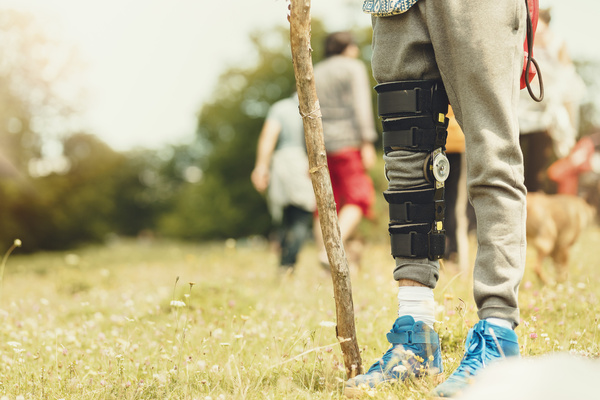7 Surprising Medical Conditions That Can Benefit from Stand-to-pee Devices
Posted by Krista Eickmann on 12th Jan 2024
The pStyle might initially seem designed for healthy athletic people, but those with medical conditions have found the pStyle to be helpful—even a lifesaver.
The ease and simplicity of peeing from a standing position is a game-changer for people living with certain chronic conditions, recovering from surgery, or simply aging. Many conditions make it difficult to sit or squat; for some people, how to pee becomes a barrier to leaving the house.
The pStyle makes life easier. Here are seven medical situations the pStyle can help with.

Foot, Leg, and Ankle Injuries
A stand-to-pee device is beneficial during recovery from broken leg bones, sprained ankles, and other leg injuries. Sitting down and standing up from the toilet can be difficult, impossible to achieve alone, and a risk for reinjury. Sitting or squatting with hard casts or leg braces may be out of the question.
The pStyle allows you to pee from a standing position without removing clothes, braces, or other medical equipment.
Arthritis
Arthritis is among the most common chronic medical conditions and can make a simple visit to the bathroom difficult. It tends to affect more women and older people.
The pStyle means you don’t have to endure the pain of sitting down or struggling with toilet paper. Importantly, you won’t get stuck sitting on a low toilet you can’t stand up from.
Older hikers can keep hiking and stay hydrated, too. You don’t have to squat to pee out on the trail.
Surgery Recovery
Packing an STP device for the hospital is a great idea.
“I genuinely urge any female having any kind of procedure done between her knees and shoulders to bring along a pStyle just in case,” wrote one satisfied customer.
Abdominal Surgeries
Common procedures like hysterectomies and hernia repair often involve incisions in the abdominal wall. Even minimally invasive procedures can result in four to six weeks of abdominal healing.
With a pStyle, you don’t have to use your core muscles to sit down and stand up from the toilet. Patients will experience less pain during recovery and greater ease when peeing.
Pelvic Floor Surgery
Pelvic floor surgeries address issues like uterine or rectal prolapse. A medical condition such as colorectal cancer can require a proctocolectomy, the removal of the large intestine.
Sitting can be intolerably painful after these surgeries. The pStyle provides a significant quality-of-life intervention during recovery, lessening pain and easing the mechanics of peeing.
Incisions in the Lower Genital Area
Episiotomy (an incision in the perineum during childbirth) and anorectal surgeries present specific recovery issues related to peeing. When a person pees sitting down, pee can run downward onto the healing incision.
Stand-to-pee devices provide comfort and protect the incision from contamination.
Urge Incontinence
Urge incontinence is when a person has a sudden, urgent need to pee at any time of the day or night. A person with urge incontinence may not be able to hold their pee until they reach the bathroom.
It is most common in older women and can seriously affect quality of life by limiting the distance a person can venture from home.
STP devices like the pStyle offer more freedom to hike, spend time in the garden, or walk through the city. When the urge arrives, peeing is fast, simple, and clean.
(See also our article on bladder health.)
Limb Amputation
People with prosthetics may have difficulty sitting, and squatting may be out of the question. Amputation can make navigating bedrooms and bathrooms difficult, especially at night.
With a pStyle, it’s easy to pee standing up without removing prosthetics. Some people can pee from a sitting position in a wheelchair.
Remember, the best stand-to-pee device is the one you’ve got when you need it. We know people who keep a pStyle in every bathroom, purse, car, and backpack!
Autoimmune or Degenerative Disorders
Sitting down is especially difficult for people with degenerative muscle disorders and some autoimmune diseases like rheumatoid arthritis or lupus.
Using a pStyle avoids the pain involved in sitting down. Plus, many toilets are low: sitting down means risking getting stuck. It’s no fun having to call for help from the bathroom.
POTS, a medical condition that may be an autoimmune disease, is associated with joint hypermobility disorders like Ehlers-Danlos syndrome. Squatting and sitting to pee might be difficult with hypermobile joints, and standing up after peeing while sitting down carries a risk of fainting with POTS.
The pStyle makes peeing a stress-free experience.
Sensory Issues
Sensory issues and chemical sensitivities bring unique challenges to peeing when needed.
These conditions may affect small numbers of people, but for those who have them, a urinary device can make all the difference.
Public Bathrooms
Hyperosmia (an overwhelming sensitivity to smells) and ligyrophobia (fear of loud noises) are two medical conditions in a list of many others that make public bathrooms inaccessible for some people.
For a person with multiple chemical sensitivities, a public bathroom means encountering scented soap, air fresheners, perfumes, and commercial detergents. The pStyle offers options for peeing discreetly outside. (See our tips for peeing in public discreetly and legally.)
“The pStyle made a 22-hour road trip possible!” one customer wrote.
Physiological Sensations
Some people experience uncomfortable sensory stimuli when sitting to pee due to the tendency of urine to get on the lower body. The pStyle helps by containing urine and keeping it from getting on the skin.
The pStyle Is for Quality of Life
Whether they’re completely healthy or experiencing any number of medical conditions, the pStyle can upgrade quality of life for anybody.
So, if you are experiencing aging, injury, surgery, arthritis, chronic illness, or sensory processing disorders — the pStyle is for you!
We love hearing about our customers’ experiences. Get in touch on our contact page.
Check out our website and the complete line of pStyles.


